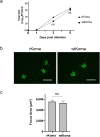Establishment of a reverse genetics system for rabies virus strain Komatsugawa
- PMID: 36171109
- PMCID: PMC9705820
- DOI: 10.1292/jvms.22-0254
Establishment of a reverse genetics system for rabies virus strain Komatsugawa
Abstract
The rabies virus strain Komatsugawa isolated from a dog in Tokyo in the 1940s retains biological properties as a field strain, providing an effective model for studying rabies pathogenesis. To facilitate molecular studies on the pathogenesis, this study aimed to establish a reverse genetics system for the Komatsugawa strain. By transfecting the full-length genome plasmid of this strain, infectious virus with artificially introduced genetic markers in its genome was rescued. The recombinant strain had biological properties similar to those of the original strain. These findings indicate that a reverse genetics system for the Komatsugawa strain has successfully been established.
Keywords: Japan; Komatsugawa; rabies virus; reverse genetics; street strain.
Conflict of interest statement
The authors declare no conflicts of interest associated with this manuscript.
Figures



Similar articles
-
Reverse genetic approaches allowing the characterization of the rabies virus street strain belonging to the SEA4 subclade.Sci Rep. 2024 Aug 9;14(1):18509. doi: 10.1038/s41598-024-69613-y. Sci Rep. 2024. PMID: 39122768 Free PMC article.
-
Genetic and Phenotypic Characterization of a Rabies Virus Strain Isolated from a Dog in Tokyo, Japan in the 1940s.Viruses. 2020 Aug 20;12(9):914. doi: 10.3390/v12090914. Viruses. 2020. PMID: 32825306 Free PMC article.
-
[Phylogenetic analysis of rabies viruses isolated from animals in Tokyo in the 1950s].Kansenshogaku Zasshi. 2011 May;85(3):238-43. doi: 10.11150/kansenshogakuzasshi.85.238. Kansenshogaku Zasshi. 2011. PMID: 21706842 Japanese.
-
Current status of canine rabies in China.Biomed Environ Sci. 2012 Oct;25(5):602-5. doi: 10.3967/0895-3988.2012.05.016. Biomed Environ Sci. 2012. PMID: 23122320 Review.
-
Research Advances on the Interactions between Rabies Virus Structural Proteins and Host Target Cells: Accrued Knowledge from the Application of Reverse Genetics Systems.Viruses. 2021 Nov 16;13(11):2288. doi: 10.3390/v13112288. Viruses. 2021. PMID: 34835093 Free PMC article. Review.
Cited by
-
Rescue of bovine ephemeral fever virus through reverse genetics, but inability to propagate.Virusdisease. 2025 Mar;36(1):48-59. doi: 10.1007/s13337-024-00901-x. Epub 2024 Dec 23. Virusdisease. 2025. PMID: 40290774
-
Reverse genetic approaches allowing the characterization of the rabies virus street strain belonging to the SEA4 subclade.Sci Rep. 2024 Aug 9;14(1):18509. doi: 10.1038/s41598-024-69613-y. Sci Rep. 2024. PMID: 39122768 Free PMC article.
References
-
- Hampson K, Coudeville L, Lembo T, Sambo M, Kieffer A, Attlan M, Barrat J, Blanton JD, Briggs DJ, Cleaveland S, Costa P, Freuling CM, Hiby E, Knopf L, Leanes F, Meslin FX, Metlin A, Miranda ME, Müller T, Nel LH, Recuenco S, Rupprecht CE, Schumacher C, Taylor L, Vigilato MAN, Zinsstag J, Dushoff J. Global Alliance for Rabies Control Partners for Rabies Prevention. 2015. Estimating the global burden of endemic canine rabies. PLoS Negl Trop Dis 9: e0003709. doi: 10.1371/journal.pntd.0003709 - DOI - PMC - PubMed

